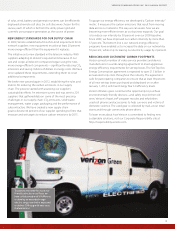Verizon Wireless 2012 Annual Report Download - page 21
Download and view the complete annual report
Please find page 21 of the 2012 Verizon Wireless annual report below. You can navigate through the pages in the report by either clicking on the pages listed below, or by using the keyword search tool below to find specific information within the annual report.
of solar, wind, battery and generator systems can be eciently
deployed at remote cell sites. Six cell sites were chosen for this
review, each of which is far from the utility power grid and
currently uses propane generators as the source of power.
NEW ENERGY STANDARDS FOR OUR SUPPLY CHAIN
In 2009, Verizon established a rst-of-its-kind requirement for its
network suppliers: new equipment must be at least 20 percent
more energy-ecient than the equipment it replaces.
The initiative set a new standard in the telecom industry. With
suppliers adapting to Verizon’s requirements because of our
size and scope, all telecom companies began using the new,
more energy-ecient components—signicantly reducing CO2
emissions and saving millions of dollars in energy costs. We have
since updated these requirements, extending them to cover
additional components.
We broke new ground again in 2012, establishing the rules and
metrics for reducing the carbon emissions in our supply
chain. The process started with assessing our suppliers’
sustainability eorts. An extensive survey tool was sent to 229
suppliers that gathered data on some of the most pressing
challenges in our supply chain: CO2 emissions, solid-waste
management, water usage, packaging and the performance of
subcontractors. We have created a new supply chain
goal to devote 40 percent of our supplier spending to rms that
measure and set targets to reduce carbon emissions by 2015.
To gauge our energy eciency, we developed a “Carbon Intensity”
metric. It measures the carbon emissions that result from moving
data across our networks. This way we can assess how we are
becoming more ecient even as our business expands. Our goal
is to reduce our intensity by 50 percent over our 2009 baseline.
Since 2009, we have improved our carbon intensity by more than
37 percent. The bottom line is our network energy eciency
programs have enabled us to increase the data on our network by
50 percent, while only increasing our electricity usage by 2 percent.
REDUCING OUR CUSTOMERS’ CARBON FOOTPRINTS
Verizon joined a number of video service providers and device
manufacturers in a wide-ranging agreement to meet aggressive
energy-eciency requirements for set-top boxes. The Set-Top Box
Energy Conservation agreement is expected to save $1.5 billion in
annual electricity costs throughout the industry. The agreement
calls for participating companies to ensure that at least 90 percent
of all new set-top boxes purchased and deployed on or after
January 1, 2014, will meet Energy Star 3.0 eciency levels.
Verizon Wireless gives customers the opportunity to purchase
environmentally-friendly devices—and safely recycle their old
ones. Verizon’s HopeLine® program recycles and refurbishes
used cell phones and accessories to help survivors and victims of
domestic violence. The used gear is collected by mail, at our retail
stores and through community phone drives.
To learn more about how Verizon is committed to nding new
sustainable solutions, visit our Corporate Responsibility site at
http://responsibility.verizon.com.
To address the need for more eco-
friendly vehicles in our fleet, we
have collaborated with VIA Motors
to develop an extended-range
electric cargo van that is expected
to deliver 100 mpg with near-zero
fuel emissions.
VERIZON COMMUNICATIONS INC. 2012 ANNUAL REPORT
19
























